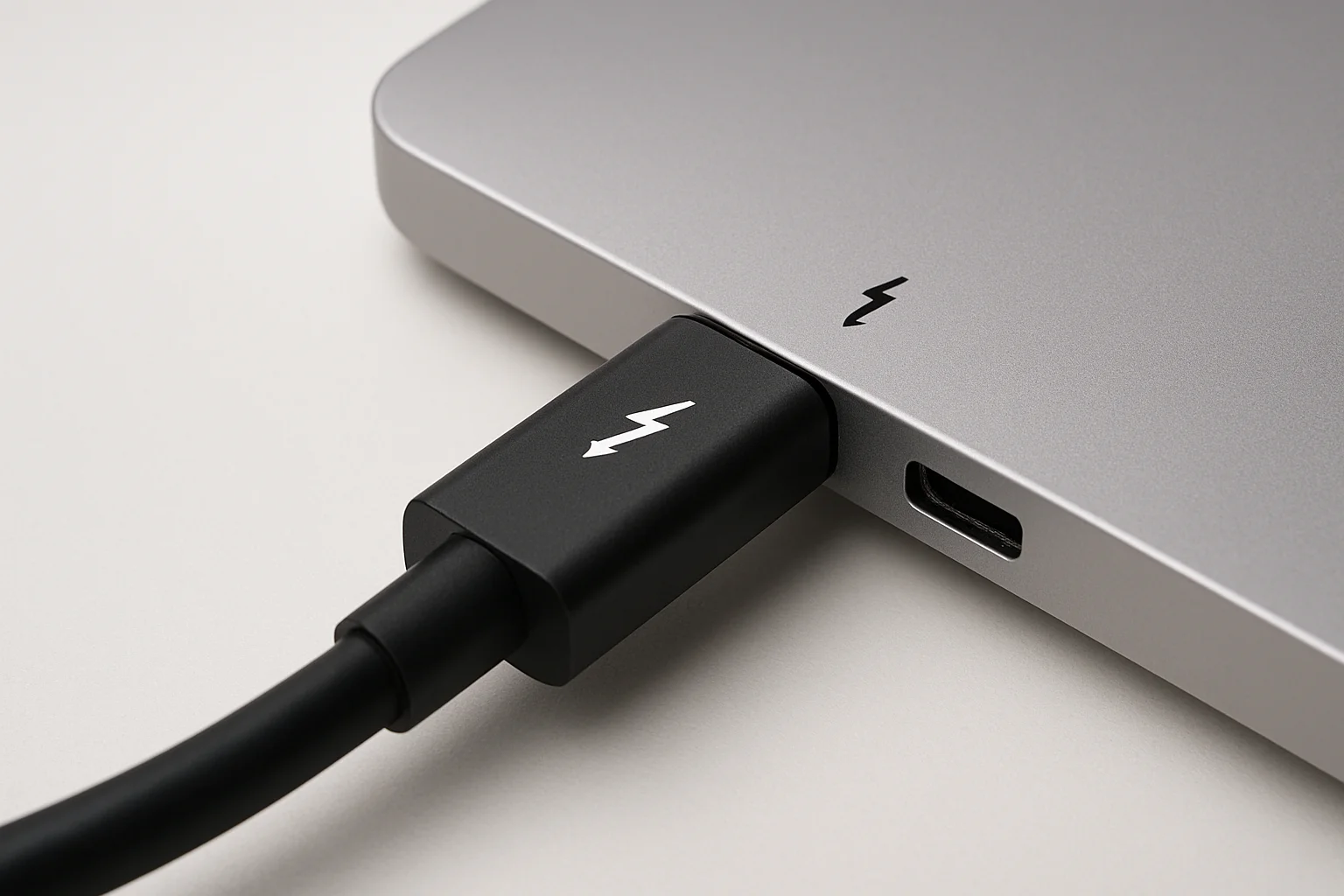The modern world of computing also relies on fast data transfer, high-quality images and convenient connection of devices without unnecessary cabling. Manufacturers therefore need an interface that can handle everything at once while remaining compact and reliable. That’s exactly what the Thunderbolt port has become. It can transfer high speed, power and video signals over a single cable and enables the use of modern monitors, docking stations and external graphics. This brings flexibility that older connectors couldn’t offer.
How the Thunderbolt port works
The Thunderbolt port uses the same connector shape as USB-C, so you can physically plug the cable into a regular USB-C port. Technically speaking, however, these are two different standards. Thunderbolt needs its own controller to handle both high-speed data transfer and video signals. If that controller isn’t in the device, it simply won’t switch to full mode and just works like regular USB-C, or won’t boot at all. The reverse is easy. Ordinary USB-C devices work in the Thunderbolt port without limitations because it is backwards compatible with the USB-C standard.
Port development has moved forward significantly. Thunderbolt version 3 brought 40 Gbps speeds and for the first time enabled the use of eGPU boxes and powerful docking solutions. Version 4 does not increase this throughput, but guarantees line stability and strict minimum requirements that devices must meet. The biggest change comes with version 5. It offers 80 Gbps in both directions and up to 120 Gbps one-way for video transmission. This enables it to support modern 4K panels with high refresh rates, professional HDR monitors and 8K displays that require high bandwidth.

With the advent of Thunderbolt 5, the cable solution is changing. Earlier generations were only able to maintain full speed with passive cables up to about eighty centimeters. Longer connections required an active cable with electronics, and it’s the latest version 5 that operates with significantly more bandwidth, making quality active cables even more important. Many users don’t realise this, and it’s often the case that a device doesn’t operate at full speed because of an unsuitable cable.
How the Thunderbolt port affects external graphics, latency and throughput
Many users want to increase the performance of their computer by connecting an external graphics card to it. This works reliably with Thunderbolt, but there are some technical limits to consider – it doesn’t carry raw PCIe lines the way a desktop PC does. Instead, it uses a transmission system in which data is sent simultaneously for graphics, video and other devices. Throughput is thus shared between multiple functions at once, which is the main reason for the limitations with eGPUs.

Generations such as 3 and 4 correspond to throughput roughly at the PCIe 3.0 ×4 level. Therefore, external graphics do not achieve the same level of performance as a card in a desktop PC, and slightly higher latency is also present. This difference is most pronounced at lower resolutions, where a lot of small data flows between the CPU and GPU. At higher resolutions, such as 1440p or 4K, most of the computation is moved to VRAM, so throughput doesn’t play as big a role and eGPU performance tends to be significantly better.
Thunderbolt 5 pushes these limits further, it’s still not a full PCIe ×16 replacement from a desktop PC, but the performance loss is less than with older generations. In practice, this means higher and more stable performance of eGPU solutions without the need to build a desktop build.
The foundation of a modern ecosystem for monitors, docks and charging
One of the biggest advantages of Thunderbolt is the ability to replace multiple cables with a single solution. When connected to a monitor or dock, video, data and power are instantly transferred, greatly simplifying use. Power Delivery-enabled monitors can deliver power directly through the same cable, eliminating the need for a separate charger. However, be aware that most Thunderbolt ports support around 100W, while USB-PD 3.1 modes can handle 140W or 240W. Thus, powerful gaming laptops often need their own charger despite the presence of Thunderbolt.
In version 5, DisplayPort 2.1 support also plays an important role. Modern 4K and 8K monitors, especially those with high refresh rates, need extremely high bandwidth that older interfaces could not provide. Thunderbolt 5 can transfer up to 120 Gbps for unidirectional video, which is sufficient for both demanding HDR panels and professional imaging. All it takes is a single cable and the laptop can power a monitor as reliably as a desktop workstation.
Conclusion
The Thunderbolt port combines data, power, and video into one fast and reliable solution. It lets you connect powerful monitors, storage and external graphics without complex cabling, turning a regular device into a full-featured workstation or gaming station. With the advent of the new version 5, both throughput and usability are increasing, confirming that this standard will play an important role in the next generation of computers.

The Thunderbolt port delivers fast data, high-quality video, and universal connectivity through a single cable. Explore devices with Thunderbolt support and take full advantage of its performance.
